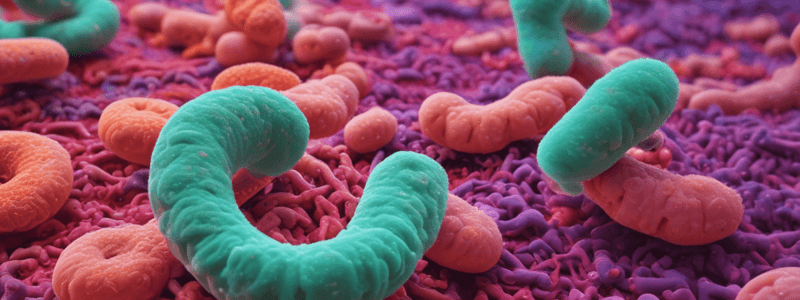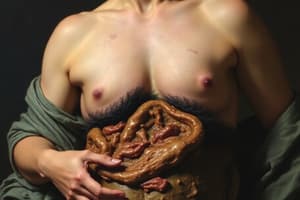Podcast
Questions and Answers
What is the key characteristic of Clostridium perfringens that allows it to survive in the environment?
What is the key characteristic of Clostridium perfringens that allows it to survive in the environment?
- It produces a potent enterotoxin
- It has a large, boxcar-shaped morphology
- It is an obligate anaerobe
- It forms heat-resistant spores (correct)
Which of the following is a classic clinical presentation of Clostridium perfringens infection?
Which of the following is a classic clinical presentation of Clostridium perfringens infection?
- Rapid tissue destruction and gas production in the wound (correct)
- Severe muscle weakness and paralysis
- Severe abdominal pain and bloody diarrhea
- High fever and septic shock
What is the primary mechanism by which the alpha toxin produced by Clostridium perfringens causes tissue damage?
What is the primary mechanism by which the alpha toxin produced by Clostridium perfringens causes tissue damage?
- It induces apoptosis in host cells
- It activates the host's inflammatory response
- It inhibits protein synthesis in host cells
- It disrupts the lipid bilayer of host cell membranes (correct)
What is the primary reason why Clostridium perfringens can cause both gas gangrene and food poisoning?
What is the primary reason why Clostridium perfringens can cause both gas gangrene and food poisoning?
Which treatment is considered the first-line therapy for Clostridium perfringens infections?
Which treatment is considered the first-line therapy for Clostridium perfringens infections?
What is the mechanism by which Clostridium perfringens can cause late-onset diarrhea?
What is the mechanism by which Clostridium perfringens can cause late-onset diarrhea?
Which toxin produced by Clostridium perfringens is responsible for the destruction of muscle tissue?
Which toxin produced by Clostridium perfringens is responsible for the destruction of muscle tissue?
What is the key diagnostic test for Clostridium perfringens infections?
What is the key diagnostic test for Clostridium perfringens infections?
What is the significance of the Nagler reaction in the diagnosis of Clostridium perfringens infections?
What is the significance of the Nagler reaction in the diagnosis of Clostridium perfringens infections?
What is the mechanism by which Clostridium perfringens causes hemolysis (destruction of red blood cells)?
What is the mechanism by which Clostridium perfringens causes hemolysis (destruction of red blood cells)?
Which of the following is NOT a characteristic of Clostridium perfringens?
Which of the following is NOT a characteristic of Clostridium perfringens?
What is the primary treatment for gas gangrene caused by Clostridium perfringens?
What is the primary treatment for gas gangrene caused by Clostridium perfringens?
Flashcards
C. perfringens survival trait?
C. perfringens survival trait?
Forms heat-resistant spores enabling survival in diverse conditions.
Classic C. perfringens signs?
Classic C. perfringens signs?
Rapid tissue destruction and gas production within the wound area.
Alpha toxin mechanism?
Alpha toxin mechanism?
Disrupts the lipid bilayer of host cell membranes.
Why gas gangrene AND food poisoning?
Why gas gangrene AND food poisoning?
It produces multiple virulence factors targeting different host tissues.
Signup and view all the flashcards
First-line C. perfringens therapy?
First-line C. perfringens therapy?
Intravenous penicillin G and clindamycin.
Signup and view all the flashcards
C. perfringens late-onset diarrhea mechanism?
C. perfringens late-onset diarrhea mechanism?
Bacteria form spores that germinate in the intestine and release toxins.
Signup and view all the flashcards
Muscle tissue destruction toxin?
Muscle tissue destruction toxin?
Alpha toxin, also known as lecithinase.
Signup and view all the flashcards
Key diagnostic test?
Key diagnostic test?
Muscle/tissue biopsy.
Signup and view all the flashcards
Nagler reaction significance?
Nagler reaction significance?
Demonstrates the lecithinase activity of Clostridium perfringens on egg yolk agar.
Signup and view all the flashcards
Mechanism of hemolysis?
Mechanism of hemolysis?
The alpha toxin directly lyses red blood cells through its lecithinase activity.
Signup and view all the flashcards
C. perfringens characteristic?
C. perfringens characteristic?
It is NOT an intracellular pathogen.
Signup and view all the flashcards
Gas gangrene primary treatment?
Gas gangrene primary treatment?
Intravenous penicillin G and clindamycin, with hyperbaric oxygen therapy.
Signup and view all the flashcardsStudy Notes
Clostridium Perfringens
- Obligate anaerobe, requiring a low-oxygen environment to survive
- Large, boxcar-shaped bacteria
Classic Presentations
- Motorcycle accidents and deep penetrating military combat wounds
- Large amounts of flesh are exposed to dirt and dust, increasing the risk of infection
Habitat and Transmission
- Forms spores found in soil, potentially contaminating open wounds
- Walnuts and knocked over dirt can harbor the bacteria, leading to infection
Diagnosis
- Muscle/tissue biopsy showing putrid discharge
- Nagler reaction uses egg yolk agar to detect the bacteria
Diseases
- Gas Gangrene: gas produced under tissue, clinically presents with crepitus and/or cracking sound on palpation, leading to destruction of muscle tissue
- Slow sign: late-onset diarrhea due to spores reproducing in the gut, leading to toxin production and potentially causing necrotizing enterocolitis
Pathogenesis
- α-toxin (lecithinase or phospholipase C): affects lipid bilayer, causing hemolysis and RBC lysis
- Hyaluronidase and collagenase: cause tissue destruction
- Heat-labile enterotoxin: causes watery diarrhea
Treatment
- 1st line treatment: IV Penicillin G, Clindamycin
- Hyperbaric O2 for myonecrosis
Studying That Suits You
Use AI to generate personalized quizzes and flashcards to suit your learning preferences.



